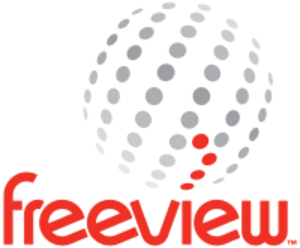Freeview (New Zealand) facts for kids
 |
|
| Industry | Digital television provider |
|---|---|
| Founded | 2 May 2007 |
| Headquarters |
,
New Zealand
|
| Products | Free-to-air television |
| Services | Digital terrestrial television Satellite television Internet Protocol television |
Freeview is New Zealand's main way to watch TV channels for free. It's like a special club run by the country's biggest TV companies. These include government-owned channels like Television New Zealand and Radio New Zealand, plus Whakaata Māori and channels from Warner Bros. Discovery New Zealand (like Three and Bravo).
Freeview offers TV in two main ways. One is a super clear, HD digital service that reaches most people in cities and towns. The other is a standard-quality satellite television service that covers almost all of New Zealand, including smaller islands. Freeview uses special digital signals called DVB-S and DVB-T.
You can also watch Freeview online! They have an IPTV service called Freeview Streaming TV. You can find this app on many smart TVs and other devices.
Freeview started in May 2007. It helped New Zealand get ready to switch from old analogue TV signals to new digital ones. This big change happened between 2012 and 2013. By 2014, Freeview was very popular, with over 60% of New Zealanders using it for their TV.
You can buy special Freeview-approved TV boxes or TVs at most shops. These make sure you get all the features. But you can also use other equipment to watch, which might be cheaper or have extra features, but might not have the full TV guide.
Contents
How Freeview Started
In June 2006, the New Zealand government announced plans for Freeview. They said it would broadcast via satellite from mid-2007 and through land-based signals from mid-2008. Freeview started advertising in April 2007. Their slogan was "Make bad reception a thing of the past."
The satellite service began on May 2, 2007. It had five TV channels: TV One, TV2, TV3, C4, and Māori Television. Soon after, a temporary channel called TVNZ Sport Extra showed V8 Supercar racing.
The land-based Freeview service, called "Freeview|HD," officially launched on April 14, 2008. It first covered major cities like Auckland, Hamilton, Wellington, and Christchurch. More areas got the service later.
In 2019, Freeview launched its streaming app, Freeview Streaming TV. At first, it only worked on certain devices. But from December 2022, it became available on many smart TVs and Android TV devices.
What Channels Can You Watch?
Freeview organizes channels based on how much the broadcasters pay for transmission services.
Popular Channels Nationwide
These channels are available across the country. Some used to be on old analogue TV, and some are digital-only.
- Original channels (also on old analogue TV):
* TVNZ 1 (government-owned, some HD) * TVNZ 2 (government-owned, some HD) * Three (some HD) * Bravo * Whakaata Māori (government-supported, some HD) * Sky Open (some HD)
- Digital-only channels:
* TVNZ Duke (some HD) * Eden (some HD) * Te Reo (government-supported) * Rush (some HD) * Al Jazeera * HGTV
Other Channels Nationwide
These channels are also available across New Zealand.
- On most national sites:
* Shine TV * Firstlight TV * Hope Channel * CH200 (land-based only)
- On metro land-based sites:
* Trackside 1 and 2 (some HD) * Parliament TV (government-supported) * TV32 * Channel 33
- Streaming only:
* Juice TV
Local Channels (Land-based only)
These channels are only available in specific local areas.
- From Kordia local sites:
* Apna Television (Auckland) * Channel 39 (Dunedin)
- From JDA local sites:
* Television Hawke's Bay (Hawke's Bay) * Wairarapa TV (Wairarapa)
Radio Channels Nationwide
You can also listen to radio stations through Freeview.
- Higher priority radio:
* Radio New Zealand National (government-supported) * Radio New Zealand Concert (government-supported)
- Lower priority radio:
* Radio Aotearoa
Channels That Are No Longer On Freeview
Over the years, some channels have stopped broadcasting on Freeview.
- Before Freeview officially launched, channels like ZEE TV, BHARAT TV, Al Jazeera Arabic, DWTV, TV5, and VOA were available via satellite.
- The Freeview|HD Demo channel 100 was removed to make space for other channels.
- TVNZ Sport Extra was a temporary channel for the 2008 Olympics.
- STRATOS (channel 21) stopped broadcasting due to costs. It later became Face TV on pay TV.
- TVNZ 6 and 7 were closed when their government funding ended. They were replaced by other TVNZ channels.
- Trackside became a pay TV channel in 2014.
- C4 closed in June 2014 to make space for a time-shifted version of FOUR.
- Other channels like Sommet Sports, Cue, tvCentral, and TV Rotorua also closed because they couldn't afford the transmission costs.
- TV29 (Panda Channel 29) closed in October 2021.
- Breeze TV and The Edge TV closed in March 2022.
TV Quality on Freeview
Freeview satellite channels are usually in standard quality (576i). However, the satellite system can handle high-definition (HD) signals. For land-based signals, broadcasters can choose to send their channels in HD or standard quality.
Currently, six channels broadcast in high definition (1080i): TVNZ 1, TVNZ 2, TVNZ DUKE, Three, Whakaata Māori, and Te Reo.
Sometimes, the quality of satellite broadcasts can go down. This happens because channels like TV ONE and TV3 are broadcast multiple times for different regions. This uses up more signal space, leaving less for other channels.
How Freeview Works (Technology)
Freeview uses two main types of technology to send TV signals:
- Land-based (Terrestrial) TV: This uses UHF signals and a technology called DVB-T H.264. It reaches about 86% of New Zealand. This system is good for New Zealand's hilly landscape because it helps avoid signal problems.
- Satellite TV: This uses the Optus D2 satellite. It broadcasts using H.262 video. This service covers almost all of New Zealand.
Freeview also certifies certain TV boxes and recording devices. This means these devices are tested to work perfectly with Freeview, especially for the electronic TV guide (EPG). These certified devices might have rules about recording HD content. However, there are also non-certified devices that might offer more freedom with recordings.
Land-based Transmitters
Freeview's land-based signals come from many transmitter towers across New Zealand. These towers are managed by companies called Kordia and Johnson Dick and Associates (JDA).
Some towers are on government land and only carry Freeview channels. Others are on commercial land. If you live in areas like Wairarapa or Southland, you might need to adjust your outdoor TV antenna to get the best signal.
Transmitters are categorized by their power:
- High-power sites (10,000 watts or more) cover large areas. Examples include Waiatarua for Auckland and Mount Cargill for Dunedin.
- Medium-power sites (500 to 10,000 watts) cover smaller regions. Examples include Kopukairua for Tauranga and Ngarara for Kāpiti.
- Low-power sites (less than 500 watts) cover very local areas. Examples include Pinehill for Auckland's North Shore and Hamilton Towers for Hamilton city.
Freeview's Costs and Competition
The New Zealand government helped pay for Freeview to get started. They contributed up to NZ$25 million and provided free radio spectrum, which is like giving Freeview free airwaves to broadcast on. The TV companies involved also paid a lot of money.
Freeview competes with other TV services like Sky. Before Freeview, many people used Sky's decoder rental to watch free-to-air channels if their analogue signal was bad. If you have a Sky dish, you can use it to get Freeview, but you'll need a separate Freeview box.
More to Explore
- Television in New Zealand
- List of free-to-air channels in New Zealand
- Digital changeover dates in New Zealand



